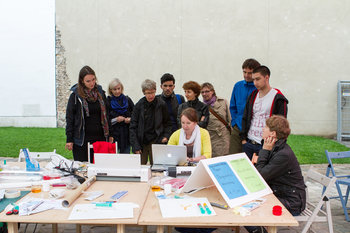Design to the Edges
Design to the edges an approach that attempts to make a design as useful for as many people as possible. For example, an elevator door that is friendly to people who are slow to get on and off such that it doesn't beep at them or close on them.Least Astonishment
Designing user interfaces to be as people expect unless there is a very good reason change it. For example, a volume knob that increases in volume as you turn to the right because this is how volume knobs have always worked such that billions of users can intuitively use your product without learning anything.There's More Than One Way To Do It
A design strategy that involves challenging the way that things are done including the fundamental assumptions of an industry. This is typically based on first principles as opposed to the traditions associated with an area of design. For example, a designer of an electric bus who looks at the problem space as an issue of transporting passengers. From this perspective, the design need not look like a bus at all.Fit For Purpose
An approach to design that meets customer needs without adding anything extra such as a plain wooden desk with no ornamentation.Less is More
Less is more is the pursuit of minimalism for minimalism's sake such that things may be removed even if they add value. For example, a white room with no distinguishing features or useful furnishings.More is Different
More is different is the idea that complexity often adds value in unexpected ways. For example, an organization that deploys hundreds of different technology products may be more resilient than an organization that standardizes on a single platform. This occurs because a single platform means that a single design flaw, limitation, bug or commercial dispute can completely disrupt business where an organization with technology diversity may continue to be efficient in the face of numerous bugs and problems.Elegance
Elegance is a design that is simple because it is complex. For example, a bathtub that accepts simple voice commands and just works as expected while hiding complexities such as energy efficiency as it reheats. This may be based on extremely complex technologies such as voice recognition AI but is remarkably simple from a usability and functionality perspective.New Complexity
New complexity is an attempt to make things as complex as possible using cutting edge technology. This is based on the philosophy that complexity beats simplicity. For example, investment bankers want big complex systems because they see complexity as a competitive advantage. To frame this more clearly, as a designer you will often be rewarded by clients for making things as big and complex as current technology allows.Essential Complexity
Essential complexity is the process of simplifying designs as far as possible without losing value. This is an attempt to look at complexity without an ideological bent as is common within the less is more and less is a bore camps. Essential complexity is critical to engineering where you can't just be removing things because you like the philosophy of minimalism.Preserving Ambiguity
Preserving ambiguity is the practice of delaying assumptions until they absolutely need to be committed. For example, an urban designer who doesn't automatically assume that a street needs to prioritize cars despite the fact that most do.Creativity of Constraints
Creativity of constraints is the idea that early constraints and assumptions can make a design more valuable. For example, a designer of high-end ice skates who starts with the requirement that the skates be 50% lighter than any other product on the market.Worse is Better
Worse is better is the idea that a design should not be over-optimized. For example, an architect who feels that a natural forest is better than a highly landscaped garden.Refinement
Refinement is the process of perfecting a design. For example, a violin designer who has spent 30 years improving the same design.Truth to Materials
Truth to materials is the principle that you not attempt to hide the true nature of materials. For example, a foam ceiling that looks like foam as opposed to having a veneer that makes it appear to be another material such as wood. Truth to materials is associated with modern design and more generally with minimalism.Emergent Design
Emergent design is an approach that allows many participants to do their own thing. For example, a video game that allows all players to build out and share environments. This is a type of emergence.Iterative Design
Iterative design is the practice of designing as little as possible at a point in time. For example, a software designer who never designs more than can be coded in a week.Minimum Viable Product
Minimum viable product is the practice of getting your product in front of customers as quickly as possible. This is a flavor of iterative design that allows feedback from the customer to be incorporated in repeated cycles.Big Design Up Front
Big design up front is the process of designing many months or years of work before work begins. For example, a city that comes up with an urban design that will take a decade to implement. This tends to be failure prone unless you continually update the design based on new information.Naive Design
Naive design is a designer who doesn't use their own product or who is disconnected from the cultures and lifestyles associated with a design. For example, a DJ turntable designed by an individual who is totally disconnected from contemporary music culture such that they have no idea how the product is really used.Value Sensitive Design
A design that reflects society, culture and values. For example, a kimono that is designed in accordance with traditional patterns, colors, materials and forms as a matter of culture.Genius Loci
Genius loci is design that reflects the spirit of a place. For example, organic architecture that uses natural materials and unassuming forms to integrate a house with a forest.Spirit of the Times
Design that captures the spirit of a time and place. This is particularly common in architecture, fashion and product design such as a fashion designer who tries to capture the mood of a season. In architecture, spirit of the times is an important aesthetic whereby it is considered more authentic to reflect contemporary culture as opposed to rehashing historical styles. Architecture plays an important role as a long lasting element of culture that reflects its time.Passive Design
Passive design is the process of making something non-electronic. For example, interior lighting based on light shelves and other daylighting techniques.Speculative Design
Speculative design is design that experiments with brave ideas. This is often done as a form of influencing. For example, a design that points to some bleak future or that proposes some dramatic change. Speculative designs are rarely implemented as anything more than a prototype but can influence the long term strategy of a society, industry or organization.Fail Often
Taking risks with design such that you expect to fail often. For example, an interior designer who experiments with prototype rooms until a client accepts a design that will span an entire building. Fail often is typically combined with fail well whereby you structure each failure to be cheap, fast and safe.Art For Art's Sake
Design that is produced as an artistic expression without commercial constraint such as an architect who designs their own house to express a vision they've had.| Overview: Design Strategy | ||
Type | ||
Definition | An overarching plan or approach behind a design. | |
Related Concepts | ||






































